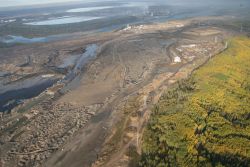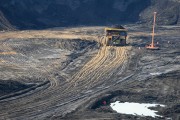Today’s protest in Ottawa and the sit-in at the White House this past month send a strong signal to Canadian and U.S. decision makers that the environmental risks and impacts from expanding oilsands development and associated pipelines are not being adequately addressed.
For those newly aware of the issues around oilsands development, the extent of civil disobedience may seem strange or even unwarranted. But the reality is that these issues have been building for a decade, with little tangible progress in the face of continued expansion.
When I started working at the Pembina Institute as a policy analyst in 2001, I confess I knew little about the oilsands. This despite the fact that I grew up in Alberta and had just completed a degree in environmental science at the University of Calgary. But I quickly became immersed in the topic: reviewing environmental impact assessments for proposed oilsands projects, conducting research on the environmental issues and policy solutions, testifying at regulatory hearings and before government committees and participating on numerous multistakeholder groups whose aim was to improve environmental monitoring and management in the oilsands region.
In hindsight, I’m both stunned and disappointed at how little progress has been made to address the environmental impacts to date and, more significantly, to ensure that development in the future is responsibly managed. Yes, there have been incremental steps. But they have been relatively small, subject to backsliding or lacklustre implementation or simply not up to the scale of the impacts they are meant to address. Little surprise that they are often dismissed as mere “greenwash.”
 These protests symbolize the disconnect between the concerns of citizens and the actions of politicians and government regulators — whether it be growing greenhouse gas pollution, threats to freshwater or endangered birds and wildlife, it is clear that Canadians and Americans alike don't believe the environment is being adequately protected.
These protests symbolize the disconnect between the concerns of citizens and the actions of politicians and government regulators — whether it be growing greenhouse gas pollution, threats to freshwater or endangered birds and wildlife, it is clear that Canadians and Americans alike don't believe the environment is being adequately protected.
The fact is, greenhouse gas emissions from the oilsands will double in the next decade and the Government of Canada has no plan for how it will manage these emissions or how it will meet Canada’s international climate commitments. Meanwhile, the Government of Alberta’s climate plan is likely only to achieve one-fifth of the province’s intended emission reductions.
Woodland caribou will be going locally extinct in the oilsands region in next 30-40 years if their habitat is not protected. Instead of intervening, the federal government has been foot-dragging for years and only recently came out with a plan that advocates killing thousands of wolves rather than moderating oilsands growth and protecting caribou habitat.
 Filling the Keystone XL pipeline with bitumen would result in nearly a 50 per cent increase in oilsands production. Approving the proposed Keystone XL pipeline — or any other oilsands export pipelines — while these concerns remain unaddressed will only serve to exacerbate the problems.
Filling the Keystone XL pipeline with bitumen would result in nearly a 50 per cent increase in oilsands production. Approving the proposed Keystone XL pipeline — or any other oilsands export pipelines — while these concerns remain unaddressed will only serve to exacerbate the problems.
Historically, people have used civil disobedience as a way to draw attention to issues they felt required urgent attention — issues like civil rights, the abolition of slavery and the universal right to vote. In those cases, law-abiding citizens — professionals, parents, young people and politicians — put their personal freedoms on the line to demand action and to challenge the injustices they saw embedded in society.
You don’t have to agree with the tactics of those demonstrating today in Ottawa, but it's important to acknowledge the message they are sending about the urgency and importance of the climate challenge, and to examine what our response, as a society, should be.
If Canadian citizens are risking arrest to make a statement about the direction Canada should — or should not — be moving in with regard to oilsands expansion, I think it’s worth listening to what they have to say.
The fact that a world-renowned climate scientist such as Dr. James Hansen was among 1,250 arrested recently during the White House sit-in should make us stop and pay attention. He’s made it clear that his participation in civil disobedience and other efforts to draw attention to the failure of our governments to take serious action on climate change are driven by his research into the earth’s climate systems, what he’s witnessed throughout his career, and his concerns for future generations.
[youtube:nvzAvN0E064,width=480]
A variety of approaches are required to drive major social and technology transitions, such as the shift towards a clean energy system. Research, analysis, policy advocacy and collaboration are the approaches the Pembina Institute uses in our work on oilsands development and other energy challenges. However, I fully support peaceful demonstrations like those happening today in Ottawa, and I would encourage Canadians to look beyond the headlines and reflect upon the deeper message conveyed by the passion and concern that drives citizens to a point of peaceful protest.
In recent years, my dad has become increasingly active on a range of social and environmental issues, from healthcare to education to global warming. And he doesn’t hesitate to do whatever he believes is required to make his message heard, from organizing meetings to writing letters to engaging in peaceful protest.
When asked why he does so, and how he finds his seemingly boundless energy, his answer is simple: “I’m a grandparent now. It makes you think about the world you’re leaving for your kids and grandkids, and it ought to be just as good if not better than the world I live in.”
Many of the citizens taking action in Ottawa today are doing so for similar reasons. Our political and business leaders ought to give careful consideration to the message these citizens delivered today on Parliament Hill, and to the motives driving such a bold statement.







